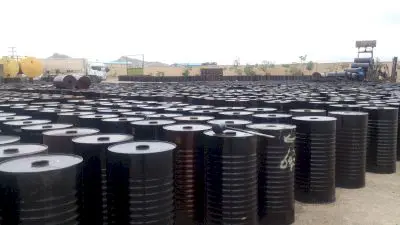Bitumen And Asphalt Market In West Asia
Bitumen occurs naturally from under the earth's crust in the form of springs, lakes and surface mines in solid and liquid form. Bitumen has been used as a waterproofing material since ancient times and in the time of Sumerians, Assyrians and even many previous civilizations. Bitumen extracted from oil or special minerals is called pure bitumen, which is classified according to its formation.
What is bitumen (asphalt)?

Bitumen, also known as asphalt, is a viscous, black, and sticky material that is primarily used in road construction and waterproofing applications. It is a semi-solid form of petroleum and is commonly obtained from crude oil during the refining process. Bitumen is composed of complex hydrocarbon molecules, including polycyclic aromatic compounds. It has a high carbon content and is classified as a highly viscous material, with properties ranging from semi-solid to solid at room temperature. Bitumen's consistency can vary depending on its source and the refining processes it undergoes.
Bitumen has several desirable properties that make it suitable for its various applications. These include high viscosity, good adhesion, flexibility, resistance to deformation under traffic, and water resistance. Bitumen can also be modified by adding polymers or other additives to enhance its performance characteristics. It is worth noting that the term "asphalt" is often used interchangeably with "bitumen" in certain regions, particularly in North America, where "asphalt" refers to the mixture used in road construction. In other parts of the world, "asphalt" generally refers to the road surface, while "bitumen" refers to the material itself.
What is bitumen (asphalt)?, Read More ...
Add your import and export orders to this list
Warning: Undefined variable $formTitle in /home/anbar/domains/anbar.asia/anbar/inc/html/desktop/orderform.php on line 10
Warning: Undefined variable $marketName in /home/anbar/domains/anbar.asia/anbar/inc/html/desktop/orderform.php on line 12
Warning: Undefined variable $location in /home/anbar/domains/anbar.asia/anbar/inc/html/desktop/orderform.php on line 12
If you want to trade in the , please join in Anbar Asia. Your order will be shown here, so the traders of contact you

How was bitumen discovered?

The discovery of bitumen dates back thousands of years. The use of naturally occurring bitumen can be traced back to ancient civilizations in Mesopotamia (modern-day Iraq) and the Indus Valley (modern-day Pakistan and India). These early civilizations observed the sticky, black substance seeping out of the ground and recognized its useful properties. Historically, bitumen was primarily used for waterproofing and sealing purposes. The ancient Mesopotamians used bitumen to seal boats, waterproof buildings, and construct water storage facilities. The Egyptians also utilized bitumen in mummification processes, as it helped preserve bodies.
In the late 19th and early 20th centuries, the modern asphalt industry began to take shape. The technological advancements in refining crude oil allowed for the production of consistent and high-quality bitumen. The first modern asphalt plant was established in the United States in 1870, and asphalt pavements became increasingly common. Today, asphalt is a vital component of the global infrastructure. It is used in the construction of roads, highways, airport runways, parking lots, and various other applications where a durable and flexible surface is required. The development of polymer-modified bitumen and advanced asphalt technologies has further enhanced the performance and longevity of asphalt pavements.
How was bitumen discovered?, Read More ...
Types of bitumen

Penetration grade bitumen is classified based on its penetration depth, which refers to the hardness and consistency of the bitumen at a specific temperature. The most commonly used penetration grades are PG 64-22, PG 70-10, and PG 76-10. These grades are often used in road construction and asphalt paving. Polymer-modified bitumen is created by blending regular bitumen with polymers such as styrene-butadiene-styrene (SBS) or ethylene-vinyl acetate (EVA). The addition of polymers enhances the physical properties of bitumen, making it more resistant to deformation, cracking, and aging. PMB is commonly used in high-stress applications, such as heavy traffic roads and airports.
Oxidized bitumen is produced by blowing air through hot bitumen, which increases its viscosity and stiffness. This type of bitumen is used in industrial applications, such as roofing, waterproofing, and pipe coating. It provides excellent durability and resistance to weathering. Hard bitumen, also known as road tar or mastic asphalt, has a high melting point and is very stiff at normal temperatures. It is used in specialized applications that require high resistance to deformation, such as bridge expansion joints, roofing, and anti-corrosion coatings.
Types of bitumen, Read More ...




